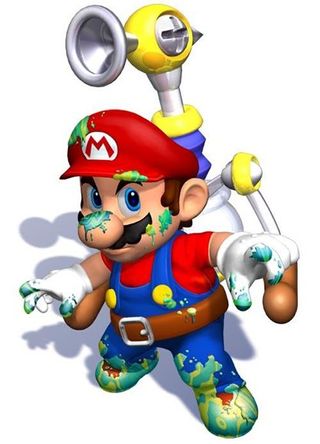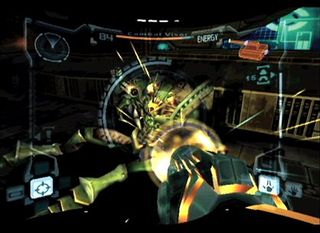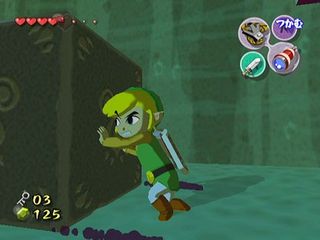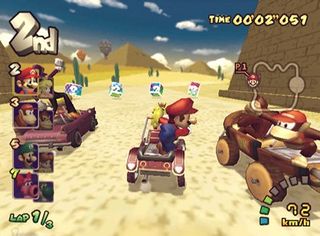We kicked off the year with the optimistic rallying cry, “2002: The year Nintendo fights back!” Optimistic, because thus far in preparation for the Big Console War of 2002, Nintendo hadn’t so much laced their gloves as reinforced their gumshields. Most observers reckoned that the sixth-gen console war was over before it began. And in the end, they were right. The PS2, fuelled by GTA III, Final Fantasy X and other similarly epic titles, had already built an insurmountable lead over the opposition. The battle for second place against new boys Microsoft was a lot more competitive though, and led to a frantic battle for the public’s affections. In the end, the consumers were the real winners.

Above: Animal Crossing was totally better than playing GTA III, right?
Microsoft cast the first stone, dropping the price of their Xbox leaving it just a hair more expensive than the planned launch price for the GameCube. At the time, this seemed like the Cube’s death knell; the Xbox was seen as the high-end ‘luxury’ console, and its shooter Halo: Combat Evolved had taken Mario Kart’s mantle as the university halls multiplayer game of choice.
Nintendo’s reply was quick, decisive and a bit shocking. Just a few weeks before the Cube’s western release, Nintendo cut the price to below what the SNES sold for in 1992.

Above: Hey Mario, you've got a little something on your face
The GameCube struggled for games initially, with only three titles available at launch, the most high-profile being the fun but disposable Luigi’s Mansion. But within months, Nintendo were dishing out the megahits with extreme prejudice. Wave Race: Blue Storm scored big, while Eternal Darkness finally emerged after four years in development hell, where it had picked up nothing more than a lovely tan. Meanwhile, people’s hopes for perfection in Super Mario Sunshine were dashed, as it may be destined to spend eternity scrapping it out with Mario 2 for the right to call itself the black sheep of the Mario family…
A strong 2002 E3 gave hope that the Cube could keep the momentum going into 2003 and beyond. Any doubts about Wind Waker were banished during an epic unveiling, in which we saw Link Jr. take to the seas for the first time. A re-jigged Metroid Prime surfaced to take the plaudits from the assembled crowd, and it would find itself in North American stores by the end of the year. In other news, Wario’s first foray into 3D was announced – and it was to be developed by no less a talent than Treasure.
Sign up to the GamesRadar+ Newsletter
Weekly digests, tales from the communities you love, and more

Above: Metroid Prime shocked everyone with its greatness
But it wasn’t all smooth sailing for Nintendo. Despite enjoying critical acclaim throughout 2002, they endured criticism for agreeing to sell their stake in highly prized developers Rare to Microsoft for a cool $375 million. With their share in Rare gone, the GameCube waved goodbye to its chances of hosting games such as Kameo and Perfect Dark Zero. Then again, after playing those games and the crummy Conker port, perhaps the sale was the right descision.
History teaches us that this was a blessing in disguise… Despite the sale, Rare were cleared to continue releasing games for the GBA (which continued to do well for itself), which meant that Donkey Kong: Coconut Crackers survived, under its new name It’s Mr. Pants! Oh God, why couldn’t you have taken him instead? *Weeps over Donkey Kong Racing’s grave*

Above: We said adios to Banjo on a Nintendo home console
Perhaps to offset the loss of Rare, Nintendo welcomed a black sheep back into their third-party fold. Square, which abandonned Nintendo to make games such as Final Fantasy VII for Sony systems in 1996, patched things up and began anew a very profitable relationship with the house of Mario. It was a day JRPG fanboys thought would never come, and they surely wept tears on their mouse pads as the story unfolded.
2002 VERDICT: 9
The Rare sale sent Nintendo fans into an inconsolable state of depression, but with hindsight, we dated them before they got old and flabby. Both the Cube and GBA saw an onslaught of quality games.
2003
Question: what was the only multiformat title to sell more copies on GameCube than on PS2 and Xbox? The answer: Namco’s superb Soul Calibur II, with the assist going to a small boy with pointy ears and a rather fetching green shift dress. We’re talking about Link, of course, who took time out of his busy schedule of polishing up his Game of the Year trophy cabinet to guest star in the GC version of Namco’s hack ’n’ slash exposition festival in September 2003. It scored big, too..

Above: Link made many souls burn
The GameCube is often remembered for its lack of third-party support, but in 2003 every man and his dog was beavering away on something a bit special for the Be-Handled Box o’ Brilliance. Over the course of the next 12 months, GC’s Top 20 list would be clogged up with non-Nintendo intruders such as Burnout 2, Hitman 2: Silent Assassin, and Worms 3D.
A further boost to the GameCube’s third-party coffers came with the announcement of the ‘Capcom Five’ – five Cube-exclusives titles from the Japanese giants. Things didn’t quite go to plan, however. Of the five titles, one was canned early on in development, and three of the remaining four were later ported to PS2. The one that did remain exclusive was probably the poorest of the lot. P.N. 03 was a super-stylish shooter featuring a saucy heroine with a gyrating pair of buttocks, but iffy bosses and level designs meant that it eventually limped over the line.

Above: It wasn't easy, but Wind Waker proved all the haters wrong
Nintendo’s own output was predictably stunning. By now, most people expected Zelda: Wind Waker to be excellent – and it was, completely reinventing the Zelda series with a graphical style that endures to this day on DS. A far bigger surprise was the critical success of Retro Studios’ Metroid Prime. The Texan developers had struggled badly during the development of the title, raising the ire of no less than Shigeru Miyamoto, who had earlier paid a trip to their offices to cancel all their other ongoing projects and to personally give each and every staff member a patented Shigeru Bitchslap (unconfirmed rumour). But when the big day arrived, it all came together, marrying a brave new first-person control scheme with the jumpy-shooty adventuring that had made Metroid so iconic. Few series have made the jump from 2D to 3D so confidently.
Two of Nintendo’s most beloved racing franchises made a comeback in late 2003, in Mario Kart: Double Dash!! and F-Zero GX (the latter of which was, in a little piece of history, co-developed by Sega). But in the real world, the company was driving around in circles. The Cube was struggling to consolidate even a second place in the console wars and Nintendo president Satoru Iwata publicly confirmed his disappointment with the company’s performance at E3.

Above: Double Dash brought the blue sparks
The only shining light was the GBA’s continued success, bolstered by the Game Boy Advance SP redesign, which introduced a fetching clamshell design, a lithium ion battery and a screen you could actually see. But there was a new challenger looming on the horizon – Sony released the first details of their upcoming PSP, which would run games off minidiscs and be more powerful than a PS1. How would Nintendo respond to this new threat? Fortunately, 2004 wouldn’t keep us waiting…
2003 VERDICT: 9
This was the GameCube’s peak year. Brilliant re-imaginings of the Metroid and Zelda franchises were underappreciated by the public at the time. Looking back, Nintendo were at the height of their creativity.
Most Popular


